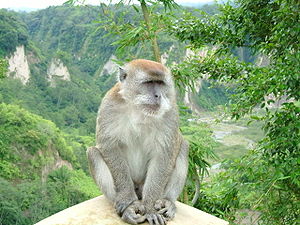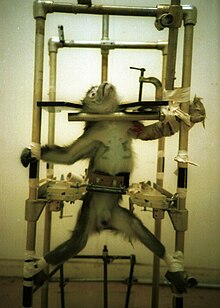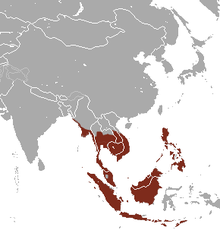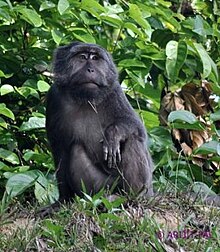Crab macaque
| Crab macaque | ||||||||||||
|---|---|---|---|---|---|---|---|---|---|---|---|---|

Crab-eating macaque at Bukittinggi |
||||||||||||
| Systematics | ||||||||||||
|
||||||||||||
| Scientific name | ||||||||||||
| Macaca fascicularis | ||||||||||||
| ( Raffles , 1821) |
The crab-eating macaque , long-tailed macaque or crab-eater ( Macaca fascicularis ) is a species of primate from the genus of macaques within the family of vervet monkeys .
features
A characteristic feature of the long tailed macaque is the long tail, which is usually longer than the rest of the animal, with a length of 36 to 71.5 centimeters for the males and 31.5 to 63 centimeters for the females. The head body length of the males is 37 to 63 centimeters, that of the females is 31.5 to 54.5 centimeters. At 3.4 to 12 kilograms, males are significantly heavier than females, which reach 2.5 to 5.4 kilograms. In addition, males also have significantly larger canine teeth . The fur is gray, gray-brown or reddish-brown and lighter on the underside, the bare face is brownish or gray in color. At the top of the head there can be a dark-colored head of hair, both sexes can have whiskers or white markings on the eyelids. The fur on the back of the newborn is dark brown or black, and their hairless face is pigmentless or rosy.
distribution
Long-tailed macaques live in Southeast Asia, their range extends from Myanmar and Thailand via Malaysia to Indonesia ( Sumatra , Java , Borneo , Lombok , Sumbawa , Flores , Timor ), East Timor and the Philippines . With the exception of humans, they are the most common primate species in the southeast. In Mauritius , New Guinea , New Britain , Hong Kong and Taiwan , Angaur ( Palau ) and some other Pacific islands were introduced by man in the Global Invasive Species Database , they are the hundred most harmful invasive alien species counted worldwide.
Subspecies and systematics
Due to the many islands in the range, numerous local forms have developed that have been described as subspecies.
- Macaca f. fascicularis , from southern Laos, southern Vietnam and Cambodia over the east and south of Thailand, the Malay Peninsula to Sumatra , Borneo , Java , Bali , the Sulu Archipelago and the Zamboanga Peninsula (Mindanao).
- Macaca f. atriceps , Ko Kham Island, off the southeast coast of Thailand.
- Macaca f. aurea , from the Teknaaf peninsula in the extreme southeast of Bangladesh via the south of Myanmar (including the Mergui Archipelago ) to the western center of Thailand and Laos.
- Macaca f. condorensis , islands of Côn Lôn and Hòn Côn Lôn Nhỏ in the Côn Đảo archipelago in the South China Sea off the coast of South Vietnam.
- Macaca f. fuscus , Simeuluë Island off the west coast of Sumatra.
- Macaca f. karimondjawae , Karimunjawa Islands in the Java Sea.
- Macaca f. lasiae , Lasia island northwest of Sumatra.
- Macaca f. philippinensis , northern and central Philippines.
- Macaca f. tua , Maratua island east of Borneo.
- Macaca f. umbrosus , on the Nicobar Islands Groß Nikobar , Klein Nikobar and Katchal .
DNA comparisons show that the long-tailed macaques consist of two clades , one (clade A), which includes the monkeys of mainland Southeast Asia and north Sumatra, and a second (clade B), which includes all other populations of the Malay Archipelago , including the crab monkey from southern Sumatra. Both clades separated from each other about 1.8 million years ago and in clade B the long-tailed monkey population on Timor was isolated from the rest about 1 million years ago.
The first description of the crab monkey comes from the British researcher and statesman Thomas Stamford Raffles . Terra typica is Bengkulu in Sumatra. From the extreme south-east of Bangladesh via Thailand, Laos to central Vietnam, the northern border of the range of the long-tailed macaque borders on the range of the rhesus monkey ( Macaca mulatta ) over a length of about 2000 km . The animals hybridize with one another at the contact zone, which is e.g. B. can be seen on specimens with a medium tail length. Y chromosomes of the rhesus monkey were found 400 km south of the contact zone.
habitat
The habitat of these animals are forests; they occur in different forest types, for example in rainforests, mangrove forests , swamp areas and bamboo forests. They also populate plantations, gardens, temple districts and are not afraid of the presence of people. The only requirement is the proximity of water.
In the wild, long-tailed macaques are one of the less threatened macaque species due to their adaptability and their large distribution area, although their habitat is increasingly restricted by clearing. They are classified as potentially at risk.
Way of life
Long-tailed macaques, like all Old World monkeys, are diurnal and mainly stay in trees. They usually move quadruped (on all fours), but can also jump distances of up to 5 meters. They also come to the ground to forage.
They live together in groups of 6 to 60 animals, which consist of several females and males. The females remain in their birth group throughout their lives and establish a hierarchy that becomes visible, among other things, in mutual grooming and access to food resources. The males also build up a hierarchy, which is determined, among other things, by sometimes violent fights - including bites with the canine teeth - which often lead to injuries. They are territorial animals that defend their territory from other groups. This includes loud shouting, hopping on the branches or presenting the long canines. If necessary, the other squad will also be driven out by force.
food
Long-tailed macaques are omnivores that feed primarily on fruits. When fruits are not available, they also eat leaves, flowers, grasses, mushrooms, but also animals such as insects and other invertebrates and bird eggs. Animals that live by the sea also eat crustaceans, snails and clams.
The subspecies ( Macaca fascicularis aurea ) occurring in the extreme northwest of the range uses stones to open nuts, mussels, snails and hard-shelled crustaceans and to get to the nutritious interior.
Reproduction
The higher-ranking males enjoy privileges in mating and reproduce with as many females as possible. After a gestation period of around 180 days, the female gives birth to a young, with most of the births occurring in the rainy season from May to July. Only the females take care of the offspring, which are weaned in the second half of their life and become sexually mature at 3 to 4 years (females) or 6 years (males). The life expectancy of these animals in human care can be up to 40 years.
Crab-eating macaques and humans
Use in animal experiments

Long-tailed macaques are widely used as research and laboratory animals. These experiments include drug tests , neurological examinations, but also studies of learning behavior . A series of experiments by Edward Taub in 1981 caused a sensation, for which parts of the spinal ganglion were severed to investigate the neuronal plasticity , so that the monkeys could not perceive either arms or legs. As a result, opponents of animal experiments named the crab-eating macaque “Laboratory Animal of the Year 2004”.
In connection with animal experiments, long-tailed macaques are also known as cynomolgus monkeys or cynomolgus .
First cloned monkey species
In January 2018, it was announced that Chinese scientists at the Institute of Neuroscience of the Chinese Academy of Sciences in Shanghai had succeeded in cloning monkeys for the first time . They used the same method that had been tested on the sheep Dolly over twenty years earlier , the somatic cell nuclear transfer (SCNT), and applied it to crab-eating macaques. The experiment produced 109 embryos , 79 of which were implanted. This resulted in six pregnancies, two of which were born alive. In any case, they survived the first forty days. They were named Zhong Zhong and Hua Hua . The aim of the experiment is to advance research into diseases in humans by using cloned long-tailed macaques as model organisms in animal experiments , possibly in combination with the CRISPR / Cas method . At the same time, the experiment raised concerns that they were on the way to human cloning.
literature
- Thomas Geissmann : Comparative Primatology. Springer-Verlag, Berlin et al. 2003, ISBN 3-540-43645-6 .
Web links
- KA Cawthon Lang: Primate Factsheets: Long-tailed macaque ( Macaca fascicularis )
- Macaca fascicularis in the endangered Red List species the IUCN 2008. Posted by: Ong, P. & Richardson, M. 2008. Accessed on May 2, 2020th
Individual evidence
- ↑ a b c d D. Zinner, GH Fickenscher & C. Roos: Family Cercopithecidae (Old World monkeys). Pages 644-645 in Russell A. Mittermeier , Anthony B. Rylands & Don E. Wilson : Handbook of the Mammals of the World: Primates: 3. ISBN 978-84-96553-89-7
- ↑ a b Rasmus Liedig, Jakob Kolleck, Kai O Böker, Erik Meijaard, Badrul Munir Md-Zain, Muhammad Abu Bakar Abdul-Latiff, Ahmad Ampeng, Maklarin Lakim, Pazil Abdul-Patah, Anthony J Tosi, Markus Brameier, Dietmar Zinner and Christian Roos: Mitogenomic phylogeny of the common long-tailed macaque (Macaca fascicularis fascicularis). BMC Genomics 2015 16: 222 doi: 10.1186 / s12864-015-1437-0
- ↑ 100 of the World's Worst Invasive Alien Species . Global Invasive Species Database. Retrieved March 30, 2011.
- ^ Lu Yao, Hongjie Li, Robert D. Martin, Corrie S. Moreaua, Ripan S. Malhi: Tracing the phylogeographic history of Southeast Asian long-tailed macaques through mitogenomes of museum specimens. Molecular Phylogenetics and Evolution, August 2017, doi: /10.1016/j.ympev.2017.08.006
- ↑ a b Michael Haslam, Michael D. Gumert, Dora Biro, Susana Carvalho, Suchinda Malaivijitnond: Use-Wear Patterns on wild Macaque Stone Tools Reveal Their Behavioral History. PLoS ONE 8 (8): e72872. doi: 10.1371 / journal.pone.0072872
- ↑ Michael Haslam et al. Archaeological excavation of wild macaque stone tools. Journal of Human Evolution, May 30, 2016; doi: 10.1016 / j.jhevol.2016.05.002
- ↑ Wild Macaques in Thailand Have Entered Stone Age report on sci-news.com with 2 videos
- ^ Laboratory animal of the year 2004: The crab macaque
- ↑ Helmut Grimm: Xenotransplantation: Basics - Chances - Risks . Schattauer Verlag, 2003, ISBN 978-3-7945-2058-9 , pp. 131 ( limited preview in Google Book search).
- ^ JP Beckmann, G. Brem, FW Eigler, W. Günzburg, C. Hammer, W. Müller-Ruchholtz, EM Neumann-Held, H.-L. Schreiber: Xenotransplantation of cells, tissues or organs: Scientific developments and ethical and legal implications . Springer-Verlag, 2013, ISBN 978-3-642-59577-6 , pp. 96 ( limited preview in Google Book search).
- ↑ Zhen Liu, Yijun Cai, Yan Wang, Yanhong Nie, Chenchen Zhang: Cloning of Macaque Monkeys by Somatic Cell Nuclear Transfer . In: Cell . tape 0 , no. 0 , ISSN 0092-8674 , doi : 10.1016 / j.cell.2018.01.020 ( cell.com [accessed January 26, 2018]).
- ↑ David Cyranoski: First monkeys cloned with technique that made Dolly the sheep . January 24, 2018, doi : 10.1038 / d41586-018-01027-z ( nature.com [accessed January 26, 2018]).
- ↑ Dennis Normile: These monkey twins are the first primate clones made by the method that developed Dolly . In: Science . January 24, 2018 ( sciencemag.org [accessed January 27, 2018]).
- ↑ Steffen Wurzel : China - For the first time monkeys were cloned with the dolly method . In: Deutschlandfunk . January 24, 2018 ( deutschlandfunk.de [accessed January 26, 2018]).
- ↑ Christiane Knoll : Animal experiments and Alzheimer's disease - Who needs cloned monkeys? In: Deutschlandfunk (ed.): Science in focus . January 28, 2018 ( deutschlandfunk.de [accessed January 28, 2018]).
- ↑ Peter Dabrock in conversation with Sandra Schulz: Cloned monkeys - "There are ethical standards that should be observed" . In: Deutschlandfunk . January 25, 2018 ( deutschlandfunk.de [accessed January 26, 2018]).



